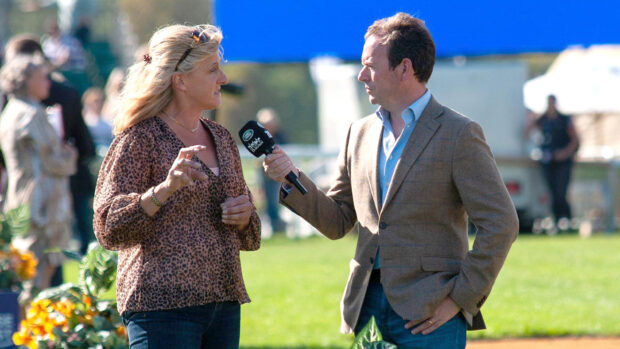Yesterday’s International Eventing Forum at Hartpury sparked some interesting discussions on the way home, from which guinea pig riders we rated through to who the forum is aimed at, which horse we’d most like to take home and which trainers we thought were best.
The morning’s session was split between Ian Woodhead and Sir Mark Todd. I wonder who gives the talks their names? Ian’s was “HOW BOTH ENDS MEET Dressage — from the ‘Beginning to the Finished Product’” and Toddy’s “THE STEPS THROUGH THE LEVELS ‘The Jumping Ladder’”.
Both talks were interesting and there were plenty of useful tips (tips from Ian; tips from Sir Mark) and exercises to take away. However, I’m not sure either really matched their titles, which are pretty broad subjects to cover in an hour.
Perhaps a more fitting name for Ian’s would have been “Dressage for the event rider and horse”. One of the most popular tips I tweeted was that before a flying change, you should create the canter you would use to jump an upright gate downhill without a frangible pin. Ian also talked about how pure dressage riders are braver in the arena, because that test is their whole three-day event and their only chance.
The E-S/O’Connor show
For me, the afternoon, with course-designer Mike Etherington-Smith and new American team coach David O’Connor, was the highlight.
There were a few references to the previous night’s discussion between the two — I’d love to have been a fly on the wall (or on the wine bottle?) for that chat.
Mike is a rare specimen among four-star designers in that he did not ride to the level himself. As such, while many superb designers run on instinct, I believe he is one of the greatest “thinkers” in the industry — he watches horses endlessly and intellectualises what he sees — as well as having natural feel. His philosophy is all about “testing riders without punishing horses”.
Hearing David was fascinating because rather than seeing an isolated lesson, I felt I was learning the skeleton of a structure which could be used to train a horse or rider throughout their careers. He talked about training for cross-country and coaching philosophy.
Riders should constantly be asked if they have noticed what happened — not just told it was good or bad. They must be able to feel mistakes or positives so they can correct the bad and replicate the good.
A suggestion
I wonder if it would be worth throwing a decent amateur rider into some of these lessons alongside the professionals? They’d need to be at the top end of novice or bottom end of intermediate so they could carry out the exercises without holding up the lesson. They’d also need a thick skin to accept that they wouldn’t be as polished as the pros and be happy for this to be pointed out. But I believe plenty of people would be jump at the chance on this basis.
Although there were four-star riders and top-level coaches in the audience, this would have the advantage of providing a rider many others could relate to and a pupil more akin to those taught by the vast majority. Most trainers don’t earn their living teaching World Class riders, but amateurs of one sort or another.
It might not work. It might take too long to see any results. They might not be good enough to really demonstrate the trainer’s points. But my tuppence worth is that it would be interesting to try it.
A date for your diaries: International Eventing Forum 2014 — Monday, 3 February.
Pippa
Tips and thoughts from Mike Etherington-Smith and David O’Connor



